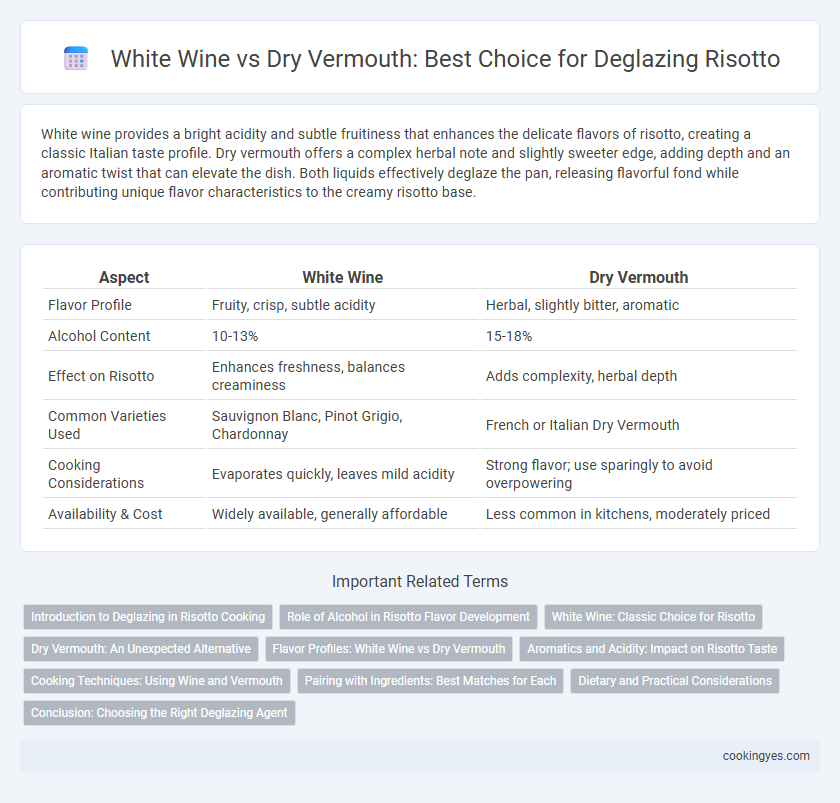White wine provides a bright acidity and subtle fruitiness that enhances the delicate flavors of risotto, creating a classic Italian taste profile. Dry vermouth offers a complex herbal note and slightly sweeter edge, adding depth and an aromatic twist that can elevate the dish. Both liquids effectively deglaze the pan, releasing flavorful fond while contributing unique flavor characteristics to the creamy risotto base.
Table of Comparison
| Aspect | White Wine | Dry Vermouth |
|---|---|---|
| Flavor Profile | Fruity, crisp, subtle acidity | Herbal, slightly bitter, aromatic |
| Alcohol Content | 10-13% | 15-18% |
| Effect on Risotto | Enhances freshness, balances creaminess | Adds complexity, herbal depth |
| Common Varieties Used | Sauvignon Blanc, Pinot Grigio, Chardonnay | French or Italian Dry Vermouth |
| Cooking Considerations | Evaporates quickly, leaves mild acidity | Strong flavor; use sparingly to avoid overpowering |
| Availability & Cost | Widely available, generally affordable | Less common in kitchens, moderately priced |
Introduction to Deglazing in Risotto Cooking
Deglazing in risotto cooking involves adding liquid to the hot pan to dissolve browned food particles, enhancing the dish's depth of flavor. White wine, commonly used for its acidity and fruitiness, brightens the risotto, while dry vermouth offers herbal and slightly bitter notes, adding complexity. Choosing between white wine and dry vermouth depends on the desired flavor profile and how it complements the other ingredients in the risotto.
Role of Alcohol in Risotto Flavor Development
Alcohol plays a crucial role in risotto flavor development by dissolving and releasing aromatic compounds from ingredients, enhancing depth and complexity. White wine, with its fruity acidity and moderate alcohol content, imparts a bright, tangy note that balances the creamy texture of risotto. Dry vermouth offers a more herbaceous and slightly bitter profile due to its botanical infusions, providing a nuanced alternative that complements savory elements while contributing subtle oxidative qualities.
White Wine: Classic Choice for Risotto
White wine remains the classic choice for deglazing risotto, infusing the dish with a balanced acidity and subtle fruity notes that enhance the creamy texture of Arborio rice. Its moderate alcohol content evaporates quickly, leaving behind flavors that deepen the overall complexity without overpowering delicate ingredients. Using a dry, crisp white wine such as Pinot Grigio or Sauvignon Blanc helps achieve the perfect harmony between richness and brightness essential for traditional risotto recipes.
Dry Vermouth: An Unexpected Alternative
Dry vermouth offers a unique alternative to white wine for deglazing risotto, imparting herbal and slightly bitter notes that enhance the dish's complexity. Unlike traditional white wine, dry vermouth contains botanicals like wormwood, coriander, and chamomile, which infuse the risotto with nuanced flavors while maintaining acidity. Using dry vermouth can elevate the umami profile and provide a sophisticated twist, appealing to those seeking innovative variations in classic Italian cuisine.
Flavor Profiles: White Wine vs Dry Vermouth
White wine offers a crisp, acidic flavor with subtle fruity and floral notes that enhance the natural creaminess of risotto without overpowering it. Dry vermouth brings a complex, herbal, and slightly bitter profile with hints of botanicals, adding depth and a nuanced savory layer to the dish. Choosing between white wine and dry vermouth depends on the desired flavor intensity and aromatic complexity in the risotto.
Aromatics and Acidity: Impact on Risotto Taste
White wine brings bright acidity and fruity aromatics that enhance the creamy texture and balance the richness of risotto, creating a fresh and vibrant flavor profile. Dry vermouth offers herbal and botanical notes with a slightly sweeter acidity, adding complexity and depth to the dish without overpowering its delicate taste. Choosing between white wine and dry vermouth influences the risotto's overall brightness and aromatic character, shaping the final sensory experience.
Cooking Techniques: Using Wine and Vermouth
White wine imparts a bright acidity and subtle fruitiness that enhances the creamy texture of risotto during deglazing, promoting balanced flavor development. Dry vermouth, infused with botanicals and herbs, contributes complex aromatic notes and a slightly bitter edge, elevating the dish's depth without overpowering. Selecting between white wine and dry vermouth depends on desired flavor intensity and aromatic profile, influencing the final risotto's taste and sophistication during the deglazing step.
Pairing with Ingredients: Best Matches for Each
White wine enhances risotto with bright acidity and fruity notes, pairing exceptionally well with seafood, mushrooms, and chicken, which benefit from its crisp flavor profile. Dry vermouth introduces herbal and slightly bitter undertones, complementing risottos featuring root vegetables, pork, or aged cheeses like Parmesan and Pecorino. Choosing between white wine and dry vermouth for deglazing depends on the desired balance, with wine providing freshness and vermouth adding aromatic complexity.
Dietary and Practical Considerations
White wine offers a natural acidity and subtle fruitiness that enhances risotto's flavor without adding calories or artificial ingredients, making it suitable for most diets including low-calorie and gluten-free. Dry vermouth, containing herbs and fortified alcohol, introduces complex aromas but may contribute more sugar and allergens, potentially limiting its use for those with sensitivities or stricter dietary restrictions. Practically, white wine is more accessible and consistent in quality, while dry vermouth's unique botanicals can complement specific risotto variations but require careful selection to avoid overpowering the dish.
Conclusion: Choosing the Right Deglazing Agent
White wine offers a classic, crisp acidity that enhances the risotto's flavor profile and balances the richness of the dish. Dry vermouth provides a slightly herbal and aromatic depth, introducing subtle complexity without overpowering the rice. Selecting the right deglazing agent depends on the desired flavor intensity and aromatic nuances, with white wine best for brightness and dry vermouth for a nuanced, savory twist.
White wine vs dry vermouth for deglazing risotto Infographic

 cookingyes.com
cookingyes.com